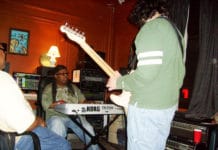by Lucas Kavner
Brooklyn, N.Y. – Ask anyone living in Cobble Hill or Carroll Gardens or Park Slope earlier this week, and they would tell you that they have power, hot water and wi-fi. In fact, most of the $1 million-plus townhouses and local businesses in Brooklyn’s wealthier neighborhoods never lost any basic necessities, even during the worst of the storm.

Power was restored on Friday, but its 12-day absence created severe conditions in the area, according to Councilman Stephen Levin, who represents the district where the Gowanus Houses is located. Many on the highest floors couldn’t get down without climbing 14 flights of stairs. Elderly residents with debilitating diseases and respiratory problems were literally stuck for a week, surviving off of food, medical supplies and flashlights donated primarily by individual volunteers, who have been working for these residents every day since Sandy hit.
One Occupy Sandy volunteer discovered a family without heat, warming their apartment with an open stove. Levin said a young girl with epilepsy was not able to plug in her nebulizer, while another woman, whose son is asthmatic, needed an electrical oxygen machine.
And as of Wednesday morning, more than a week after Sandy hit, at least two of the buildings at the Gowanus Houses were still without power, though a few residents said that number was actually five, and many others were without hot water and heat. Comparatively, power had been restored to most NYCHA complexes last week, including those in Lower Manhattan, Queens and other parts of Brooklyn.
On Wednesday, residents wandered the grounds of the Gowanus complex, escaping dark apartments as icy winds picked up, and another storm and cold front with a new name – Athena – prepared to touch down in New York. Spirits were low.

Pat, an older woman who wished not to give her last name, huddled under an umbrella with her daughter. She also lived in one of the buildings without power. “You hear stories; a lot of people are talking,” she said. “But we don’t know anything. I guess it’s just one of those things where it comes back on when it comes back on. We just have to wait and see.”
Across the street, a NYCHA generator and other equipment hummed as housing agency employees continued to work in the damaged basement. Those workers declined to speak to The Huffington Post. Another man in a NYCHA hat walked by quickly.
“I wish I had answers, I don’t have answers,” he said. “Go into the building office. They might know something.”
But the building office didn’t know anything, either. Neither did the general Brooklyn office of NYCHA, whose representative seemed at the end of her rope.
“Nobody’s here. They’re all out there, preparing for the next storm,” said the woman on the other end of the phone. “I don’t know when anyone’s coming back. Hopefully! Hopefully they are. Just try again later.”
The situation at Gowanus Houses isn’t unique. Generally, those in public housing have had a tougher time than many others in the wake of Sandy. While Con Edison reported that about 88,000 New Yorkers were still without power mid-week, NYCHA public housing residents made up a significant portion of that number – with more than 13,000 still without power on Thursday and over 20,000 without heat and hot water.

The New York Post reported that the darkness in the stairwells and general unease in Red Hook had sparked serious crimes, including two reported rapes and multiple muggings. A hand-written sign taped to one of the entrances there, read: “WE ARE NOT ANIMALS!”
‘Quite dire’
Red Hook was generally hit harder during Sandy than the neighborhood surrounding the Gowanus Houses, so the continuing outages were extra frustrating to residents who couldn’t understand why their building was still struggling to regain basic necessities, while the surrounding area had been almost completely restored.
Councilman Levin – who had been back and forth from his nearby office to the Gowanus Houses all week – said he understood their frustrations and has been significantly exasperated with the lack of communication from NYCHA.
“One way to alleviate the communication divide would be to communicate,” he said, referring to NYCHA. “That would be the first step.”
He noted that NYCHA employees have certainly been working hard, some taking 48-hour shifts around the city, but they were inevitably stretched thin during this “national disaster of mammoth proportions.” He said NYCHA had hired a private contractor who ideally would have started work last week, but only began working to repair damaged cables a week after the storm hit. Levin said he could have started much sooner and wasn’t sure why it had taken him so long to begin. ConEd had been ready to restore power to these buildings immediately, he said, but only as soon as those initial repairs were done.
“When you’re in a situation like this,” Levin said. “Cost should be the last consideration.”

“I think it’s important to be fair when we look at which one of our buildings is still down versus the surrounding communities,” he said. “Eighty percent of power has been restored to 400 buildings without power. Over 70 percent of heat and hot water was restored.”
Levin, however, wondered why NYCHA, which is funded in part by the United States Department of Housing and Urban Development (HUD), wasn’t sending federal contractors or generators to help coordinate this power outage. It’s a major emergency, Levin said, and everyone should be stepping in to help immediately. Why, he asked, had it taken so long for so many public housing buildings to get back up and running?
Howard Husock, vice president for policy research at the Manhattan Institute and an expert on housing and urban policy, said the essential problem is that NYCHA’s model is outdated.
“The management structure of public housing doesn’t even work in the best of times,” Husock said. “The utilities – the boilers and other infrastructure is extremely antiquated and is not being renovated or replaced at the same cycle a private owner would undertake. And long-term under-funding problems with NYCHA can’t be fixed through any combination imaginable in the current offerings of rent increases or federal aid, which isn’t going to happen because of the federal budget situation.”

“Everybody here was hoping and praying it’d be a matter of just flipping a switch,” Brown said. “These units have been there for years. Maybe folks have to be relocated, that could be a possibility, too. They’re working all of these things out.”
When asked whether HUD realized how severe the situation had become at many city public housing buildings, he said that the department comprehended the scope of the crises. “I think they know it’s an emergency,” he said. “Unfortunately it’s not as simple as anyone would like it to be.”
However, Husock of the Manhattan Institute holds that there are simple moves that should and could be made, like “airlifting” blankets and other supplies for these residents, or even opening up the Barclay’s Center, the new Brooklyn Nets arena in downtown Brooklyn, as a shelter.
“I’m calling this a slow-motion Katrina for public housing residents,” Husock said. “The situation is quite dire. It’s stunning to me that there isn’t more attention being paid to this.”
Lucas Kavner, a New York writer and performer whose essays have appeared in the Washington Post and whose videos have been featured in the New York Times and Russia Today, among many other media, can be reached at lucas.kavner@huffingtonpost.com. This story first appeared Nov. 9, 2012, on the Huffington Post.

 Store
Store







